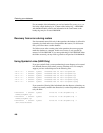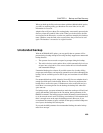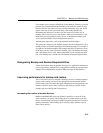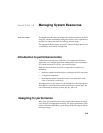
Determining your data backup and recovery strategy
414
Scheduling routine backups
Make a full backup of each database just after you create it, to provide a base
point, and perform full and incremental backups on a fixed schedule thereafter.
It is especially important to back up your database after any large number of
changes.
Your backup plan depends on:
• The load on your system
• The size of your database
• The number of changes made to the data
• The relative importance of faster backups and faster recovery
Determining the type of backup
When you decide whether to do a full, incremental, or incremental_since_full
backup, you need to balance the time it takes to create the backup with the time
it would take to restore. You also should consider media requirements. A given
incremental backup is relatively quick and takes a relatively small amount of
space on tape or disk. Full backups are relatively slow and require a lot of
space.
Incremental_since_full is somewhere in between. It starts out as equivalent to
incremental, but as the database changes and the number of backups since a full
backup increases, incremental_since_full can become as time-consuming and
media-consuming as a full backup, or worse.
In general, the opposite is true for restore operations. For example, if you need
to restore from a very old full backup and a dozen or more incrementals, the
restore may take longer and the backup may use up more space than a new full
backup.
The obvious advantage of incremental backups is that it is much faster and
takes less space to back up only the data that has changed since the last backup,
or even since the last full backup, than to back up your entire database. The
disadvantage of relying too heavily on incremental backups is that any eventual
restore takes longer.


















